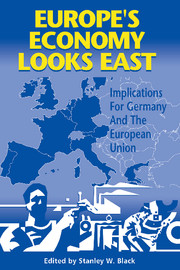Book contents
- Frontmatter
- Contents
- List of figures and tables
- Preface
- List of conference participants
- List of acronyms
- 1 Introduction
- I Trade relations
- II Investment patterns
- 5 Investment and its financing during the transition in Central and Eastern Europe
- Comments
- 6 Privatization, structural change, and productivity; toward convergence in Europe?
- Comments
- III Labor market issues
- IV The process of integration
- Index
6 - Privatization, structural change, and productivity; toward convergence in Europe?
Published online by Cambridge University Press: 03 February 2010
- Frontmatter
- Contents
- List of figures and tables
- Preface
- List of conference participants
- List of acronyms
- 1 Introduction
- I Trade relations
- II Investment patterns
- 5 Investment and its financing during the transition in Central and Eastern Europe
- Comments
- 6 Privatization, structural change, and productivity; toward convergence in Europe?
- Comments
- III Labor market issues
- IV The process of integration
- Index
Summary
Introduction
With the demise of the command economy, the economic East–West division of Europe became visible, and it turned out to be much bigger than anticipated. With German unification occurring in 1990, it quickly became apparent that the GDR – widely presumed to be the leading economy in terms of per capita income of the ex-CMEA (the former Soviet bloc Council for Mutual Economic Assistance) – did not match the consensus estimate of 50 percent of West Germany's per capita income and labor productivity. With the fall of the Berlin wall and the collapse of the socialist CMEA integration scheme and of the USSR, the wide East–West income gap became fully apparent. The Eastern European transformation process as well as economic opening up rendered part of real and human capital obsolete in the ex-CMEA area so that the European East–West economic divide became transitorily aggravated. Output levels in 1995 will about match those of 1989 in the ex-GDR, in Poland, and in the Czech Republic. The share of mining in industry fell by two thirds in the period 1990–94, the share of investment goods by more than 10 percentage points, while the construction industry – supported by special investment incentives – almost doubled its share. Overall, except for an overextended government sector (20.9 percent compared to 13.2 percent in western Germany) and an underdimensioned service industry (27.7 percent compared to 36.2 percent in western Germany), eastern Germany's economic structure had become rather similar to that of West Germany (Heilemann and Löbbe, 1995).
- Type
- Chapter
- Information
- Europe's Economy Looks EastImplications for Germany and the European Union, pp. 212 - 257Publisher: Cambridge University PressPrint publication year: 1997
- 1
- Cited by



